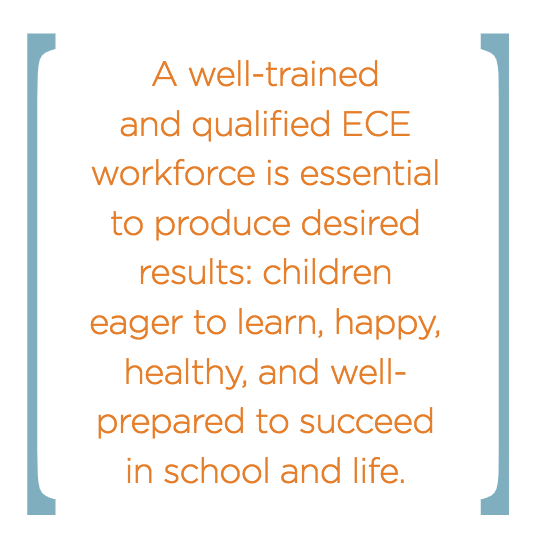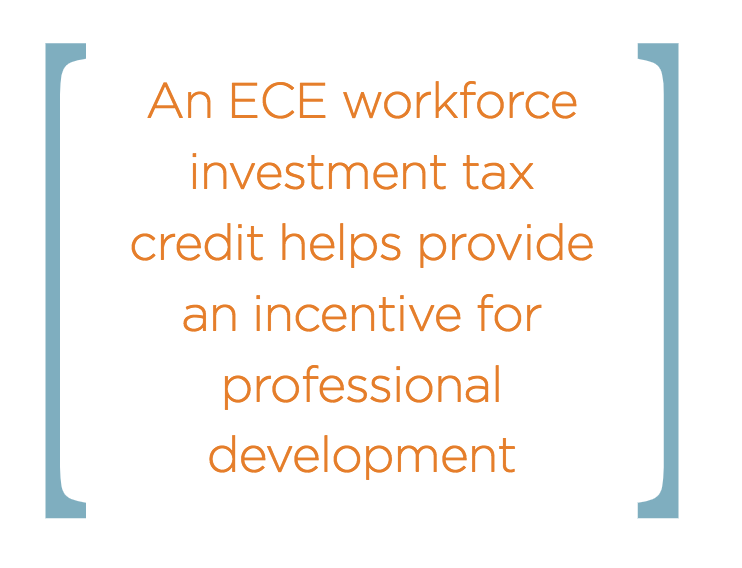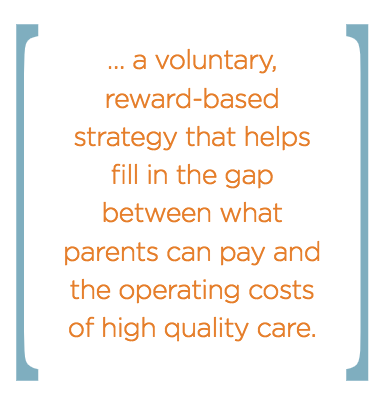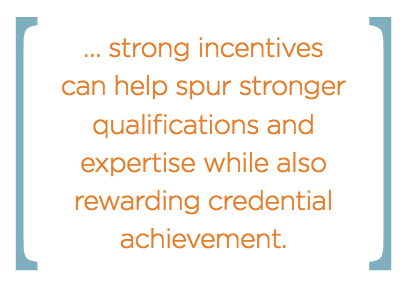Policy Brief
Pathways to High-Quality Child Care: The Workforce Investment Credit

Pathways to High-Quality Child Care: The Workforce Investment Credit discusses the state of the early care and education workforce and recommends a proven first step towards linking professional development with a refundable tax credit. The policy offers a model to other states and an informed economic investment in the nation’s future. This policy brief was generously supported by the Alliance for Early Success and the Foundation for Child Development.
State Infographics
New evidence at the intersection of neurobiology, developmental science, and economics carries vast implications for how we think about the responsibilities, skills, and qualities of children’s early childhood teachers: their influence on early brain and behavioral development, their responsibility for managing many children’s first encounters with peers and introducing children to a school-like environment; and their own well-being as it affects their capacity to support young children’s learning and healthy development. It ups the ante on what is at stake when children’s earliest caregivers and teachers – two thirds of whom have children of their own – experience economic hardship, diminished social status, and other chronic stressors that all-too-often accompany early childhood employment. The affected outcomes range from early brain development to educational success to the talent pool available to future employers.
This important brief summarizes the evidence and recommends a proven first step towards addressing the widespread lack of return on investments made by the early care and education (ECE) workforce in their own skills and qualifications, as well as the high turnover rate in the field. The intentional policy, implemented by Louisiana, to reward educational attainment within the ECE workforce and improve earnings (without increasing parent fees), offers a model to other states, a wise economic investment in the nation’s future, and an acknowledgement of the value of early childhood teachers of whom we expect so much, but provide so little.
-Dr. Deborah Phillips Professor of Psychology, Georgetown University
Index
- Introduction
- In Brief
- Child Care Affects Our Future Economic Prosperity
- High-Quality Child Care Can Influence Childrens Brain Development Over the Course of Their Lives
- Improving the ECE Workforce Has Multiple Benefits
- The Louisiana Approach Works
- The ECE Workforce Investment Credit is a Sensible Solution
- Business Leaders Understand Workforce Quality
- Endnotes
Introduction

The investments we make now in our future workforce—today’s youngest generation—lay the groundwork for a prosperous economy tomorrow. The science related to brain development shows that a child’s experiences in the first years of life set the foundation for learning, including school readiness. As with other construction projects, the quality of materials used to build this foundation—early learning settings such as child care and Pre-K—has significant implications for children’s lifelong knowledge, skills, and capabilities.
A well-trained and qualified early care and education (ECE) workforce is essential to produce desired results: children eager to learn, happy, healthy, and well-prepared to succeed in school and life. Attracting and retaining such a workforce is a longstanding challenge in the United States because pay is based on what parents can afford. This limitation impacts the ability of early childhood educators to advance their education and training and acquire research-based skills and competencies that best promote early learning in young children. This brief discusses (1) the state of the ECE workforce, including low compensation, and (2) how one state’s approach using a refundable tax credit links professional development with a modest wage increase.
In Brief

The quality of child care has long-lasting repercussions for our future workforce. We can promote better child care by investing in the professional development and adequate compensation of child care providers. An early childhood workforce investment credit, modeled after the Louisiana school readiness tax credit, rewards professional development for child care providers and can foster the quality ECE workforce necessary to promote children’s learning and school readiness.
Child Care Affects Our Future Economic Prosperity

Quality child care matters for children’s healthy development, early learning, and safety. The factors that contribute to quality care include a secure and stimulating environment in which to learn, a workforce trained to encourage brain development through responsive interactions with children, and professional development that prepares early learning educators to identify potential problems early on, so appropriate interventions can be made available. Currently, these factors are not sufficiently addressed.
- The quality of child care is directly related to the quality of the workforce.
- Low compensation for the child care workforce makes it hard to attract and retain high quality staff.
- Low compensation makes it difficult for the current workforce to access the training and higher education necessary to acquire the knowledge and competencies for delivering high quality care.
An ECE workforce investment tax credit helps provide an incentive for professional development, and rewards educational attainment with a refundable wage credit to increase pay


High-Quality Child Care Can Influence Childrens Brain Development Over the Course of Their Lives
Child care is an important place for children’s early skill development and a support for working parents. Currently, more than 15 million children under age six have working parents.1 Many of these children are in some type of child care setting every week. Numerous studies have shown that all children, and particularly low income children, benefit from high quality care.2 This care can help launch a lifetime of better health, education, and career outcomes.
Neuroscience research confirms that a child’s earliest years are critical for brain development. From birth to age five, the architecture of the brain is built rapidly, laying the foundation for future social, emotional, cognitive, and physical development. Because both genes and experiences play a role in brain development, children’s interactions with the adults and environments around them influence the brain’s architecture.3 Research shows that the quality of care can either positively or negatively affect a child’s development.4
Improving the ECE Workforce Has Multiple Benefits
A high-quality ECE workforce is necessary for high-quality child care and early learning. The right scaffolding can support the capacity of the ECE workforce to help children build strong brains in the earliest years of life. According to the National Survey of Early Care and Education, more than one million paid staff work in about 130,000 child care centers throughout the United States. Another one million caregivers are paid home-based providers caring for children in their residence.5 Two-thirds of the staff working in centers do not have a college degree.6 For home-based providers, the level of education is lower than center-based staff, with many having no more than a high school degree.7 In other words, many child care providers have not had the education and professional training that can support them in their role as vital agents of children’s early learning and skill development.
The workforce is underdeveloped as a result of the dominant business model in the child care industry. Parent fees are the only source of revenue to cover operating expenses for most programs (such as rent, utilities, materials, insurance, and wages for staff). Parents struggle with the high cost of care, which often leads to decisions to hire staff at the lowest wages possible so that programs can keep parent fees as low as possible. As a result, the median hourly wage for an individual working in child care is $11.65 per hour (about $24,230 per year).8 In fact, over half (53 percent) of child care workers reside in families enrolled in one or more public support programs annually, compared to 21 percent of the U.S. workforce as a whole.9


Low pay restricts the ability to hire and retain quality staff and leads to turnover, which research has shown is about 25 percent among centers with turnover.10 Low pay can also contribute to provider stress, which research demonstrates can lead to lower quality classrooms. Teachers who are more depressed and stressed have been observed to be less sensitive, more intrusive, and harsher in classroom interactions with children.11 This results in less supportive, less responsive interactions between children and their caregivers and disrupts children’s development and well-being. Consistent staffing in care settings is a challenge but essential for children’s healthy development given the importance of stable relationships with supportive adults.
Boosting the wages of child care providers based on achieved competencies, certificates, or educational levels is a voluntary, reward-based strategy that helps fill in the gap between what parents can pay and the operating costs of highquality care. With the market constrained by parent fees, it is a way to both promote family choice among quality settings and help support a quality workforce.
The Louisiana Approach Works
Practical, viable solutions to the challenge of developing a high-quality ECE workforce already exist. Louisiana pioneered its School Readiness Tax Credits in 2007.12 One component of that package provides ECE directors and staff with a refundable credit linked to their educational attainment at four levels and work experience in a quality program. The credit amount increases as the credentials rise.
Educational attainment is verified through the state’s early childhood career development registry (called Pathways), and employment is verified by the center where they work. It is not an entitlement—only those individuals who voluntarily join the registry, achieve professional development, and have been working for at least six months in a licensed program that participates in the state quality rating system qualify for the credit.13
The credit is adjusted for inflation annually. In tax year 2016, the value of the credit by qualification level ranged from $1,658 to $3,315 and a total of 4,044 individuals claimed it. The average credit was $2,154, a modest investment that links professional development with a wage increase.14
Between 2008 and 2015, the number of staff achieving a Teacher Level 1 credential (a Child Development Associate credential) grew from 963 to 3,598, an increase of 374 percent, and the number of staff that attained higher-level credentials (Levels 2, 3, and 4) increased almost eight-fold, from 284 to 2,156.15 Use of the credit shows that strong incentives can help spur stronger qualifications and expertise while also rewarding credential achievement.

The ECE Workforce Investment Credit is a Sensible Solution
Raising a healthy population of future workers, citizens, and parents starts with high-quality child care settings. Quality care depends on attracting, retaining, and growing a well-trained workforce that is fairly compensated for its skills and expertise. In every state, child care workers earn low wages.16 As long as parent fees remain the revenue source driving the operating budgets of child care programs, compensation is unlikely to change, limiting the ability to provide high-quality care.
The keys to designing a workforce investment credit are:
- Making the credit refundable so the lowest paid providers can benefit from a wage increase;
- Indexing the credit to inflation;
- Structuring the credit large enough to matter (e.g., at least a 10 percent increase); and
- Linking the credit to qualifications.
The framework for this policy is already in place. Quality rating systems are operating in nearly every state and the District of Columbia.17 Voluntary state registries are operating in 44 states.18 Because it is voluntary, individuals working in child care select whether to participate and only receive the credit for educational levels actually achieved.
Business Leaders Understand Workforce Quality

Business leaders know a quality workforce matters. Investing in quality early learning settings can lead to more children starting school ready to learn. When children start school ready to learn, they are more likely to experience positive academic and health outcomes, which in turn will lead to a stronger future workforce and more engaged citizens. Businesses understand the concept of return on investment—a higher rate of return in productivity and income is derived from improving the quality of our human capital development.
The bottom line: investing in a quality ECE workforce allows parents to work, supports children’s healthy development, promotes a skilled workforce pathway and more sustainable regional economies in communities across the country—now and in the long-term.
Endnotes
- U.S. Census Bureau, 2019 American Community Survey 1 Year Estimates, Table B23008, Age of Own Children Under 18 Years in Families and Subfamilies by Living Arrangements by Employment Status of Parents.
- Yoshikawa, H., Weiland, C., Brooks-Gunn, J., Burchinal, M., Espinosa, L., Gormley, W., Ludwig, J., Magnuson, K., Phillips, D., Zaslow, M., (2013). Policy Brief, Society for Research in Child Development and the Foundation for Child Development, Investing in Our Future: The Evidence Base for Preschool Education.
- Harvard University, Center on the Developing Child, Brain Architecture.
- U.S. Department of Health and Human Services, National Institutes of Health, National Institute of Child Health and Human Development, The NICHD Study of Early Child Care and Youth Development, 2006.
- U.S. Department of Health and Human Services, Office of Planning, Research and Evaluation, Number and Characteristics of Early Care and Education (ECE) Teachers and Caregivers: Initial Findings from the National Survey of Early Care and Education (NSECE), October 2013.
- Ibid.
- Ibid.
- U.S. Bureau of Labor Statistics. Occupational Employment and Wages, Child Care Workers (2019).
- Whitebook, M., McLean, C., Austin, L.J.E., & Edwards, B. (2018). Early Childhood Workforce Index – 2018. Berkeley, CA: Center for the Study of Child Care Employment, University of California, Berkeley.
- Whitebook, M., Phillips, D., and Howes, C., Worthy Work, Still Unlivable Wages: The Early Childhood Workforce 25 Years After the National Child Care Staffing Study, University of California Berkeley (2014).
- Pianta, R., Downer, J., and Hamre, B.; The Early Care and Education Workforce. Phillips, D., Austin, L., and Whitebook, M. , The Future of Children, “Starting Early: Education from Prekindergarten to Third Grade,” The Future of Children, Vol. 26, Number 2, Fall 2016. Chapters: Quality in Early Education Classrooms: Definitions, Gaps & Systems.
- Louisiana School Readiness Credits, FAQs for Child Care Staff
- Ibid.
- Louisiana Department of Revenue (2017), Louisiana School Readiness Tax Credit
- Ibid.
- U.S. Bureau of Labor Statistics. Occupational Employment and Wages, Child Care Workers (2016).
- Build Initiative, QRIS State Contacts & Map
- National Workforce Registry Alliance, Membership Map

This brief was produced by the Committee for Economic Development with funding from the Alliance for Early Success. We want to express our gratitude to Anne Mitchell and Louise Stoney for serving as the primary research authors of the brief.







